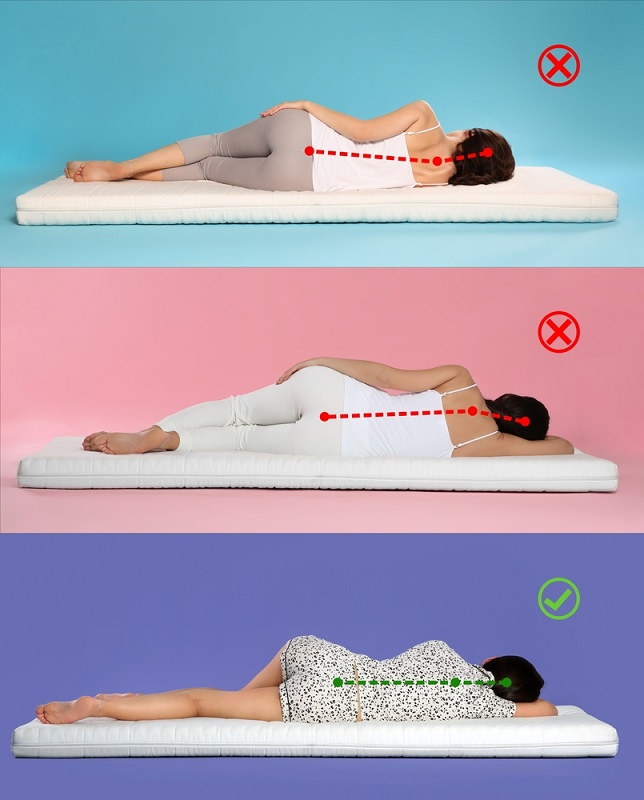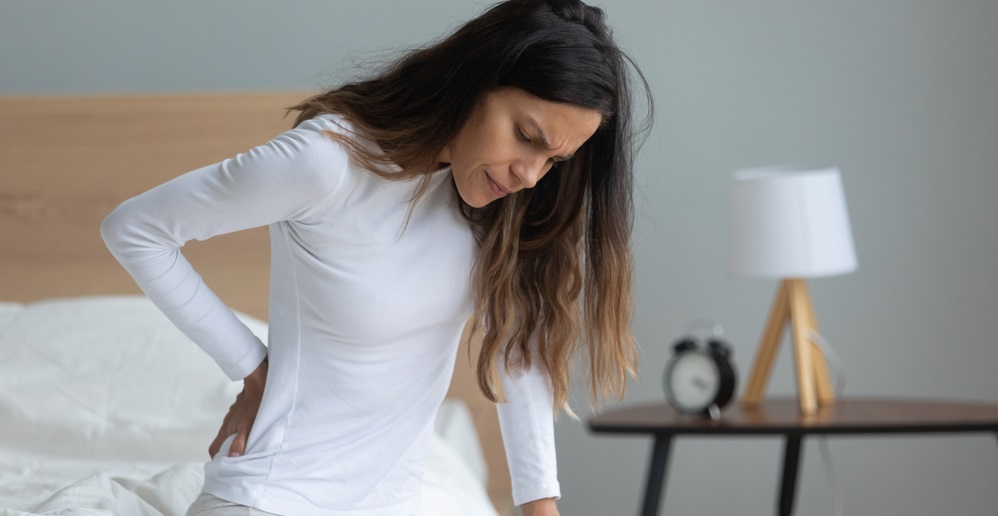Sleep is emerging as something we need to optimize just as much as we do our food and water intake. Without a solid average of 7 to 9 hours of sleep per night, our mental and physical health often suffer.
If you’ve ever gone for a few days without getting regular sleep, you know how mentally and physically challenging it can be. Poor sleep over many years is a huge contributor to dementia, obesity, heart disease, depression, and high blood pressure.
Back pain is a common reason why you can have poor sleep. More than half of us have back pain at some point in life. While most back pain is mechanical and self-limited, sleeping in the wrong position or on a poor mattress can lengthen the duration of your back pain and worsen your overall sleep quality.
Fortunately, you can improve not just your back pain but also your sleep quality by adopting the sleep positions known for improving your pain. You spend a third of your life sleeping; when this time is spent in the best positions for back pain, you can promote better healing and enhance the quality of your waking life as well.
The Importance of Sleep Positions
The way you sleep is important, even if you’re healthy. When researchers study the way a human is lying (on their back, sides, or stomach), they find large differences in the tension placed on the back muscles.
Lying supine (on your back) is least likely associated with back muscle tension, while lying prone (on your belly) is most linked to this type of muscle tension. Side sleeping is generally okay as long as your spinal column is kept straight.
Improper sleep positions can exacerbate preexisting back pain and can even cause back pain when none existed before going to bed. Depending on how you sleep, you can awaken with neck or lower back pain just because you slept “wrong” the night before.
One common position linked to side sleeping is called “provocative” because it often provokes back pain. In this position, you are lying on your side, but while your upper body is truly on your side, your upper leg is not supported, and your hips become twisted. This leads to your upper leg often ending up in front of the bottom one, also resting on the bed.
Because any sleep position can lead to back or neck pain, you may need to look carefully at the interaction between the kind of pain you have and your specific sleep position. If you have chronic neck pain, for example, the causative factor(s) and corrective actions will be different than if you have lower back pain.
In other words, you need to be able to tailor your sleep position to the kind of pain you’re having, particularly if your pain is worse upon getting out of bed in the morning.
Best Sleep Positions for Back Pain

What are the different sleep positions you can adopt for enhanced sleep comfort and reduced back pain? Which sleep position is best if you’re having back pain? Which sleep positions are the worst for back pain?
Back Sleeping
Sleeping on your back is usually the best option for those with back pain. When you sleep on your back, the major benefits are these:
- Back sleeping permits relaxed abdominal and back muscles
- Your spine is almost always aligned when you sleep on your back, relieving stress on both sides of the spinal column
- Back sleeping can further improve back pain if you place a pillow beneath your knees
You can easily attain this position by lying on a medium-firm mattress that supports your hips so they don’t sink too deeply into the bed. If you use a pillow beneath your knees, make sure that the pillow lifts the knees equally.
Your head pillow should not be placed only beneath the back of your head (the occiput) but should also support your shoulders in ways that keep the natural inward curvature of your neck.
Your arms should be by your side or across your chest. Try not to have your arms and hands above your shoulders, as this can cause neck tension.
Side Sleeping
Side sleeping can also be effective in managing back pain, but with a few caveats. If you can maintain a straight spine while sleeping, you can also reduce morning back pain.
You should have a family member or friend look at your spine while lying on your side in bed to make sure your spine is straight in your mattress of choice.
Advantages of side sleeping include:
- Reduced back and neck pain
- Better breathing if you have sleep apnea
- Reduced heartburn
- Improved back pain when pregnant (and it’s better for your baby, too)
You need to make sure your hips are not rotated in a provocative side-lying position. In order to ensure straight hips, you may need to support them by putting a small pillow between your knees or using a U-shaped pregnancy pillow that similarly supports your spine. The pillow beneath your head should straighten your neck.
The fetal position does not necessarily help reduce back pain; however, people with spinal stenosis may notice that forward flexion in the fetal position reduces back-related sciatica pain.
Stomach Sleeping
Sleeping on your stomach is the least desirable of all of the sleeping options for back pain. Sleeping this way (called “prone sleeping”) tends to hyperextend your back beyond its natural curvature.
You generally need to turn your head to the side for prone sleeping; this can contribute to neck pain and does not keep your entire spine straight.
If you need to sleep on your stomach for other reasons, you may need to talk to a professional about your pillow options. Sleeping with a body pillow that allows you to be partially prone may help instead of sleeping fully prone.
If you have no other choice but to sleep prone, your mattress should be firm so that your belly doesn’t sink into the bed. You can also invest in a pillow for use under your hips and lower belly to take the stress off your lower back muscles.
Pillow and Mattress Considerations
It is difficult to fully assess the best sleep positions for your back pain without looking at how much your pillows and mattresses are potentially contributing to the problem.
A mattress with dips in it from long-term use will usually make back pain worse, regardless of the position you choose. A good medium-firm mattress ensures that your spine is kept straight when side-sleeping or prone sleeping.
Your mattress is best kept medium-firm, but you may find that memory foam top layers, gel layers, or special cooling materials can also enhance your sleep and reduce back pain. Water beds are rarely good options for back pain as they do not support the spinal column.
Your pillow should allow you to have a normal neck curvature while on your back. Use small travel pillows or bolster pillows in places around you where they help you maintain a comfortable sleep position.
Any of these pillows can be used behind your back, beneath your knees, or under your hips to enhance your sleep. Try not to spend too much money on expensive pillows that may not be any better than inexpensive ones.
In general, soft or medium latex pillows work as well as others for back and neck pain; however, you can also experiment with microbead pillows or hard foam pillows if they seem to help your specific neck or back issues.
Conclusion
If you awaken with more pain than you had at bedtime, you likely need to reassess your sleeping position. While sleeping on your back is generally considered best for back pain, you can explore side-sleeping as long as your spine isn’t twisted during sleep.
Make use of pillows to support your chosen position. Pillows beneath your knees, between your knees, or behind your back to help you maintain an optimal sleep position for you.
Most people benefit from a sleep position personalized for their unique health issues, including those unrelated to back pain. Seek outside help from a professional if you have difficulty finding a good sleep position to ease back pain and enhance your overall health.

